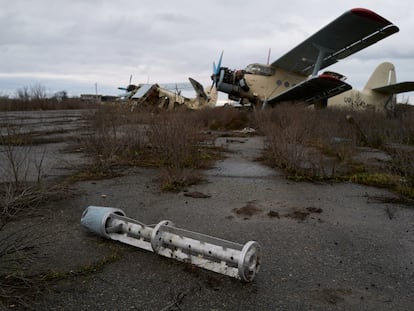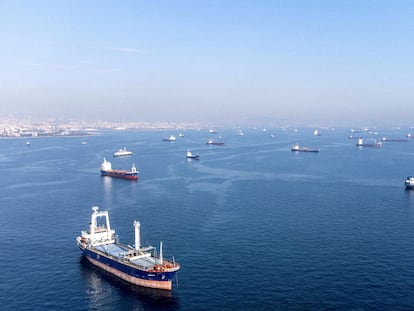A small haven in Ukraine: ‘Yesterday, we managed to escape from hell!’
Near the Russian trenches in the east of the country, there’s a lake with a beach where civilians and soldiers try to forget the war

Dozens of people are relaxing on the beach. Some are taking therapeutic mud baths. The waters are calm, with a high salt content. The sun is warm, but not scorching hot. Children race around, while mothers, lying on their beach towels, forgetting about the world for a moment.
In the distance, you can hear the roar of engines — there’s a convoy of military vehicles on the move. The caravan breaks the idyllic scene beside this lake in the Ukrainian city of Slovyansk, whose name means “city of salt.” It’s a reminder that — only 12 miles away — Russians and Ukrainians are fighting in the trenches.
“Yesterday, we managed to escape from hell!” exclaims a young soldier, with a bare chest and an almost festive tone. He sports tattoos of a bullet and a Cossack. The words around the images read, “for Ukraine, for its freedom.” He’s surrounded by several comrades, all of whom hail from the Kyiv region. Some are wearing swimsuits, while others are already back in their camouflage after enjoying a leisurely afternoon in this part of the eastern Donetsk region.
Beside the lake, there are food vendors, two massage tables, umbrellas for sale, lounge chairs for rent and a stall offering temporary tattoos. There are groups of uniformed men who, upon approaching the water, strip down to their underpants and dive in.
Mikola — 56-years-old and originally from the city of Lutsk — is one of the oldest bathers. He tells EL PAÍS that he started fighting in 2015, at the beginning of the war in this eastern region of Ukraine. But now, due to his age, he’s no longer on the frontlines. “I’m a little older now, but I’m still protecting my country,” he clarifies, while wearing a khaki shirt and camouflage pants. He waits for some of his colleagues to finish dressing on the sand.
This lake scene wouldn’t be at all unusual if it was taking place anywhere else. However, for this reporter — who was just in Chasiv Yar, in the middle of the hellish Bakhmut district — the contrast is shocking. It’s enough to take a walk through the spa area and chat with those who’re hanging out on the shore to understand that this relaxation is a kind of survival.
“Here, in this particular place, no bombs have ever fallen,” Viktor, a 71-year-old retiree, notes in a reassuring tone, while sitting on the shore, smearing his joints with mud. More than the possible insecurity, his main concern is massaging himself with the black earth, which he scoops up with his wrinkled hands. “I’ve been coming here to treat myself, very often, for the last 10 years. If you come just once in a while, it doesn’t work. I try to come for 10 days in a row, and then I rest,” he details. Nothing is left uncovered: wrists, elbows, knees, shoulders. “This mud has many mineral properties,” he smiles.
Sloviansk was occupied by pro-Russian forces nine years ago. Three months after the invaders’ incursion, in July 2014, it was recaptured by the government in Kyiv. But despite the serenity that Viktor conveys from his mud bath, the city has constantly been under threat ever since. Since the full-scale Russian invasion was launched in February 2022, Slovyansk and neighboring Kramatorsk have been priority targets for the invaders. Today, both are militarized cities that endure, under the protection of the local armed forces. This is despite the fact, at the end of May, Bakhmut — some 25 miles away — fell into Russian hands after a 10-month-long bloody battle.
“It’s very difficult for the body and mind to be in a perpetual state of alert,” says Amparo Villasmil, the head of mental health for Doctors Without Borders (MSF) in Ukraine. This Venezuelan psychologist understands that these visits to the lake aren’t a way to deny war or danger. Rather, they’re manifestations of a need to survive — a self-defense mechanism in the face of adversity.
In the parking lot, the hood of a Lada car acts as a tray for some glasses, beer bottles and clothes from a group of visitors who, before concluding the day of enjoyment, ask to be photographed together, as a memory. They say that they’ve come straight from their positions on the frontlines to take a dip, almost implying that there’s something good about their battle stations being so close to the lake.
“You can go crazy without pleasures like this,” says Oleg, a 42-year-old member of the Special Forces, who’s looking forward to a new mission. Some crumbs from the kebab that he’s eating slide down his chest, onto the rosary that he wears next to a medal of the Virgin. “This serves to reduce psychological tension — it gives you a feeling of relief,” he sighs.
According to the experience of Dr. Villasmil, who arrived in Ukraine last January, the Ukrainian communities that are 12 or 15 miles from the frontlines “have the desire to be able to build a kind of life around the reality of war: [there are] traditions, walks, gatherings of friends, activities with children. These are ways to support oneself in the group, in the community,” he affirms. “Resuming all these activities helps to mitigate the impact [of the war], which is still present and cannot be denied.” These excursions, he adds, are moments that help the residents deal with anxiety and post-traumatic stress.
Viktor, the retiree, says that this lake on the outskirts of the city of Slovyansk is the only one with all the services, cafés and kiosks accessible to the local population. “There’s another one farther away, but it’s private, and you have to pay [to access it]. This is municipal — the facilities have improved a lot since 2018. It’s also good for children, because it’s shallow,” he adds, while raising his hands to where the water level barely reaches one-and-a-half feet. “Some people take the mud home in bags or cans, especially those who come from far away. There are other similar places, but they’re in areas occupied by the Russians.” The slight movement of the retiree’s hands draws waves on the surface of the water. In the reflection, you can see the salt factory that rises near the lake, its large chimney emitting steam.
“Human beings end up adapting, for better and for worse, in the midst of everyday life. Maintaining permanent alert is very hard — we need spaces or moments of relaxation. You have to be able to disconnect in the midst of the threat, the missiles, the alarms,” explains the psychologist from MSF.
“We all have some fear, but not as much as last year. If I have to flee, I have my bike,” Viktor shrugs. Behind him, a few dozen feet away, shines the dome of the Church of the Resurrection of Christ — a witness to this haven of peace at the gates of war.
Sign up for our weekly newsletter to get more English-language news coverage from EL PAÍS USA Edition
Tu suscripción se está usando en otro dispositivo
¿Quieres añadir otro usuario a tu suscripción?
Si continúas leyendo en este dispositivo, no se podrá leer en el otro.
FlechaTu suscripción se está usando en otro dispositivo y solo puedes acceder a EL PAÍS desde un dispositivo a la vez.
Si quieres compartir tu cuenta, cambia tu suscripción a la modalidad Premium, así podrás añadir otro usuario. Cada uno accederá con su propia cuenta de email, lo que os permitirá personalizar vuestra experiencia en EL PAÍS.
¿Tienes una suscripción de empresa? Accede aquí para contratar más cuentas.
En el caso de no saber quién está usando tu cuenta, te recomendamos cambiar tu contraseña aquí.
Si decides continuar compartiendo tu cuenta, este mensaje se mostrará en tu dispositivo y en el de la otra persona que está usando tu cuenta de forma indefinida, afectando a tu experiencia de lectura. Puedes consultar aquí los términos y condiciones de la suscripción digital.
More information
Archived In
Últimas noticias
Most viewed
- Sinaloa Cartel war is taking its toll on Los Chapitos
- Oona Chaplin: ‘I told James Cameron that I was living in a treehouse and starting a permaculture project with a friend’
- Reinhard Genzel, Nobel laureate in physics: ‘One-minute videos will never give you the truth’
- Why the price of coffee has skyrocketed: from Brazilian plantations to specialty coffee houses
- Silver prices are going crazy: This is what’s fueling the rally










































